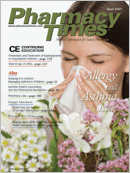Publication
Article
Pharmacy Times
case STUDIES
Author(s):
CASEONE:
EC, a healthy 22-month-oldtoddler, is brought to thepediatrician's office with a 1-to 2-week history of loosestools. His mother reportsthat EC has loose stools 6 to 7times per day. This contrastswith the 1 to 2 stools that henormally has. The consistency of EC's stools is so loose thathis diapers are unable to contain them.
On physical examination, the pediatrician finds EC to be aplayful, happy toddler in no acute distress. His vital signs are:
- Blood pressure: 125/75 mm Hg
- Heart rate: 75 beats/min
- Respiratory rate: 24 breaths/min
EC has gained 2 lb since his last physical and remains in the75th percentile for his age. Except for perineal erythema dueto frequent stooling, the pediatrician does not report anyabnormal findings during the physical examination. The physician,suspecting that EC has giardiasis, decides to send astool sample for evaluation for ova and parasites. The resultsof the laboratory testing confirm the pediatrician's suspicionsby reporting the presence of numerous Giardia lamblia cysts.The pediatrician explains the results to EC's mother andwrites a prescription for EC to start furazolidone 8 mg/kg/daydivided into 4 daily doses for 10 days.
EC's mother is very concerned about the diagnosis, particularlywhen the pediatrician explains that giardiasis is oftenreferred to as a "swimming pool" disease. The disease is oftentransmitted via swimming pool water due to contaminationwith feces from an infected swimmer. EC's mother frequentlytakes her children to the lake to swim. Although her otherchildren do not have symptoms, she asks the pediatrician ifshe should treat all of the children.
Should all of her children be treated even if they are asymptomatic?
CASE TWO:In a rural town, a mothercomes to the walk-in cliniclocated in the local pharmacy.She has brought 7 childrenwith her; 6 are her own, rangingin age from 4 months to 6years. The other child, aged 3,is her niece who has beenstaying with them while hersiblings are recovering from "some sort of sickness."
The mother explains that her niece has developed symptomssimilar to those the siblings had. She is concerned thather children will also develop symptoms. She describes a 3-day history of fever, a hacking cough, clear rhinorrhea, nasalcongestion, decreased appetite, and decreased activity.Although the fever has resolved, a rash has appeared on thechild's face and neck. Now the rash is progressing downward.
On physical examination, the practitioner notices a generalized,erythematous, maculopapular rash. The girl's oralmucosa is red and granular with white spots on it. She alsohas conjunctivitis with watery eyes and photophobia.
The practitioner is concerned that the symptoms are consistentwith measles. He contacts the health department andconfirms that the girl's siblings were all reported as beingserology-positive for measles.
When the practitioner informs her of the suspected diagnosis,the mother admits that her own children were never immunized.She wants to know what can be done to protect her childrenfrom developing measles. Are there any measures thatcan be used to prevent measles in exposed children?
Dr. Schlesselman is an assistant clinical professor at the University of Connecticut School of Pharmacy.
Click Here For The Answer ----------->
[-]
CASE ONE: Treatment is not necessary for children who are asymptomatic. Colonization with Giardia does not appear to harmthe children. Treatment does not reduce the infection rate. The Centers for Disease Control and Prevention recommends treatment of asymptomaticchildren who are not having diarrhea if they have nausea, fatigue, weight loss, or a poor appetite. If several family members developsymptoms (or several children within a day care center), screening and treating of asymptomatic children may be appropriate.
CASE TWO: If given within 72 hours of exposure, measles vaccination may provide some protection for children over the age of 1 year.Postexposure vaccination is preferable to immune globulin in most cases. Immune globulin should be used in exposed individuals who are pregnantor immunocompromised. Exposed children under the age of 1 year should receive immune globulin.
toggle(getObject('exp1048685570_link'), 'exp1048685570');







